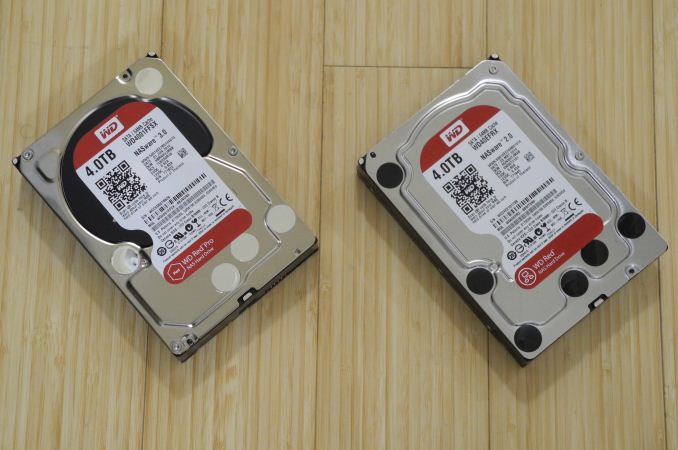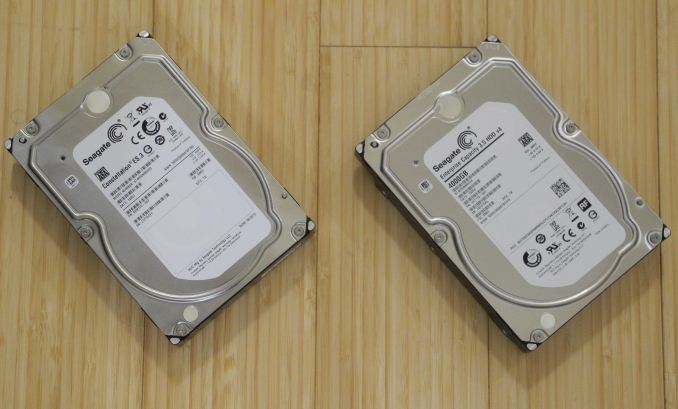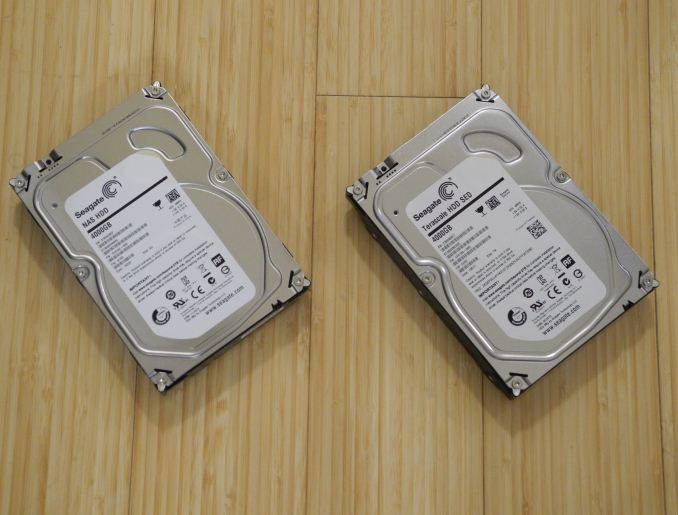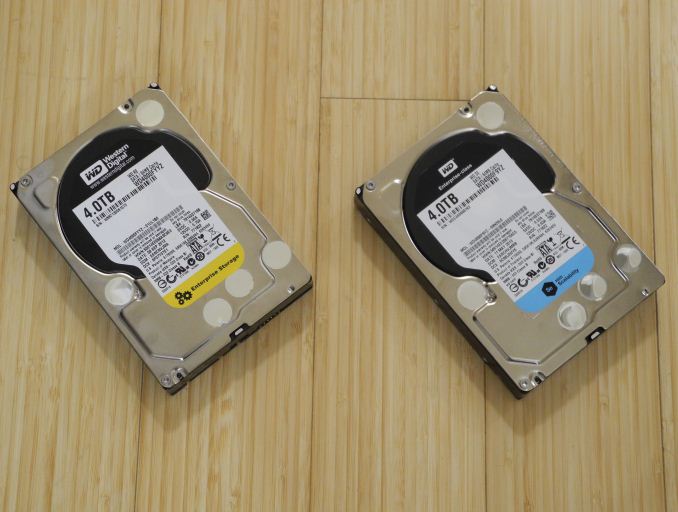WD Red Pro Review: 4 TB Drives for NAS Systems Benchmarked
by Ganesh T S on August 8, 2014 9:00 AM EST4 TB NAS and Nearline Drives Face-Off: The Contenders
Prior to getting into the performance evaluation, we will take a look at the special aspects and compare the specifications of the ten drives being considered today.
Western Digital Red Pro 4 TB
The Red Pro is meant for 8-16 bay SMB / SME rackmount units. Compared to the WD Red, it has better performance, thanks to its 7200 RPM rotational speed. While the WD Red has utilized 1 TB and 1.2 TB / platter configurations, the Red Pro units have 600 GB and 800 GB platters for the 2 / 3 TB versions and the 4 TB version respectively. The lower areal density platters have been in production for quite some time, allowing Western Digital to use a more mature configuration for the Red Pro parts. Like the enterprise drives, the Red Pro comes with hardware-assisted vibration compensation, undergoes extended thermal burn-in testing and carries a 5-year warranty.
Western Digital Red 4 TB
The 4 TB WD Red that we evaluated for this piece is the same as the one that we used in last year's roundup, i.e, the NASware 2.0 version and not the NASware 3.0 version. Even though the WD Reds initially targeted 1-5 bay systems, NASware 3.0 updates the vibration handling mechanism (firmware / calibration) to enable usage in 1-8 bay units. Despite the firmware not being upgradable for older models, WD is honouring warranties even if the NASware 2.0 drives are used in 6-8 bay units. Other aspects of the WD Red models have already been touched upon in our previous reviews.
Seagate Constellation ES.3 4 TB
The Constellation ES.3 lineup is last year's enterprise play (sixth-generation) from Seagate in this market space. It targets applications where capacity, performance and durability under heavy workloads are primary considerations. The drives have a standard 7200 RPM spindle speed, but differ from other units by having a 128 MB multi-segmented cache on-board (64 MB is the standard nowadays). All models are 512N (i.e, native 512 bytes per sector, enabling usage without performance loss for legacy applications).
Seagate Enterprise Capacity 3.5" HDD v4 4 TB
The Enterprise Capacity 3.5" HDD features Seagate's eighth generation drive technology and retains the 128 MB cache of its predecessor. The main difference is that there are no 512N models (either 4K native for the 6 TB model, and 512 emulated for the others). Seagate happens to be the first to use 1 TB platters for its enterprise drives, and this has enabled the Enterprise Capacity lineup to include 6 TB variants. For this review, we managed to get hold of the 4 TB version. On the basis of paper specifications, it looks to be a very good alternative to the WD Red Pro.
Seagate NAS HDD 4 TB
The NAS HDD lineup goes head-to-head against the WD Red. The slightly higher spindle speeds (5900 RPM vs. 5400 RPM) tends to give it the performance advantage at the cost a slight power consumption penalty. Seagate implements the NAS-specific firmware features as part of the NASworks package. We have looked into various features of the NAS HDD lineup in our previous roundup.
Seagate Terascale SED 4 TB
Seagate also supplied us the Terascale drives for this roundup, since we had the WD Se in our previous roundup. The Terascale (previously Constellation CS) goes head-to-head against the WD Se in all departments - it is meant for applications where scalability / capacity is a primary factor, followed by low power consumption and cost. Both 5900 and 7200 RPM versions are available, but our review units belonged to the former category and came with the Instant Secure Erase feature. Unlike the other Seagate enterprise drives in our review samples, this one comes with 64 MB of cache. Seagate claims lowest power consumption in the enterprise drive category for the Terascale drives.
Western Digital Re 4 TB
The Western Digital Re is meant to go head-to-head with the Seagate Constellation ES.3 and Enterprise Capacity 3.5" HDD v4. The application areas are the same - enterprise applications where performance, reliability and durability under heavy workloads are primary requirements. The Re drives are the highest-performing SATA drives from Western Digital. The Xe drives are a class above the Re, but they are available only in capacities of up to 900 GB and come with a SAS interface only. We have been using Re drives in all our NAS reviews so far.
Western Digital Se 4 TB
The Se drives come from WD's Datacenter Storage Business Unit and meant for applications where scalable storage (i.e, reliable storage which doesn't cost an arm and a leg for scenarios where capacity, rather than performance, is of primary importance). WD uses them in their own datacenter. Like other enterprise drives, they come with a self-encryption option and carry longer warranties. When compared to WD Re, the difference comes in the URE (unrecoverable error rates), MTBF ratings and suggested workloads. Further details can be seen in our launch coverage of the WD Se.
Toshiba MG03ACA400
The MG03ACA400 is Toshiba's highest capacity nearline storage device targeting enterprise applications. The specifications are standard - a 7200 RPM drive with a 64 MB buffer. Toshiba makes it clear that the drives target entry-level servers, storage arrays and RAID systems - There is no emphasis on extreme performance, so it is only fair to expect it to slot with the WD Se and Seagate Terascale drives rather than the Re and Enterprise Capacity ones. The street price (as of the time of this article going live) is similar to that of the Terascale, and this only reinforces our perception.
HGST Ultrastar 7K4000 SAS
The HGST Ultrastar 7K4000 is the odd-one out in our sample set today. We had requested HGST for the SATA version of the 7K4000, as that goes head-to-head with the Re, Constellation ES.3 and the Enterprise Capacity drives, but they only had the SAS interface version available for review sampling. The standout aspect of the Ultrastar lineup is the 2.0 million hours MTBF rating. Comparing SATA and SAS drives are like comparing apples and oranges, but, at least, we have the same 7200 RPM spindle speed and 64 MB buffer like most of the other drives. As mentioned in the previous section, we are only going to look at the RAID-5 performance benchmark numbers for this drive in today's review.















62 Comments
View All Comments
sin_tax - Thursday, August 21, 2014 - link
Transcoding != streaming. Most all NAS boxes are underpowered when it comes to transcoding.jaden24 - Friday, August 8, 2014 - link
Correction.WD Red Pro: Non-Recoverable Read Errors / Bits Read 10^15
Per Hansson - Friday, August 8, 2014 - link
I'm not qualified to say for certain, but I think it's just marketingbullshit to make the numbers look better when infact they are the same?
Non-Recoverable Read Errors per Bits Read:
<1 in 10^14 WD Red
<10 in 10^15 WD Red Pro
<10 in 10^15 WD Se
Just for reference the Seagate Constellation ES.3, Hitachi Ultrastar He6 &
7K4000 are all rated for: 1 in 10^15
shodanshok - Friday, August 8, 2014 - link
Hi, watch at the specs carefully: WD claim <10 errors for 10^15 bytes read.Previously, it was <1 each 10^14.
In other word, they increase the exponent (14 vs 15), but the value is (more or less) the same!
jaden24 - Friday, August 8, 2014 - link
Nice catch. I just went and looked up all of them.RE = 10 in 10^16
Red Pro = 10 in 10^15
SE = 10 in 10^15
Black = 1 in 10^14
Red = 1 in 10^14
Green = 1 in 10^14
It looks like they switched to this marketing on RE and SE. The terms are in black and white, but it is a deviation from a measurement scheme, and can only be construed as deceiving in my book. I love WD, but this pisses me off.
isa - Friday, August 8, 2014 - link
For my home/home office use, the most important aspect by far for me is reliability/failure rates, mainly because I don't want to invest in more than 2 drives or go beyond Raid 1. I realize the most robust reliability info is based on several years of statistics in the field, but is their any kind of accelerated life test that Anandtech can do or get access to that has been proven to be a fairly reliable indicator of reliability/failure rates differences across the models? I'm aware of the manufacturer specs, but I don't regard those as objective or measured apples-apples across manufacturers.If historical reliability data is fairly consistent across multiple drives across a manufacturers' line, perhaps at least provide that as a proxy for predicted actual reliability. Thanks for considering any of this!
NonSequitor - Friday, August 8, 2014 - link
If you're really concerned about reliability, you need double-parity rather than RAID-1. In a double parity situation the system knows which drive is returning bad data. With RAID-1 is doesn't know which drive is right. Of course either way you should have a robust backup infrastructure in place if your data matters.shodanshok - Friday, August 8, 2014 - link
Mmm... it depends.If you speak about silent data corruption (ie: read error that aren't detected by the build in ECC), RAIDZ2 and _some_ RAID6 implementation should be able to isolate the wrond data. However this require that for every read both parity data (P and Q) are re-calculated, hammering the disk subsystem and the controller's CPU. RAIDZ2, by design, do this precise thing (N disks in a single RAIDZ array give you the same IOPS that a single disk), but many RAID6 implementation simply don't do that for performance reason (Linux MDRAID, for example, don't to it).
If you are referring to UREs, even a single parity scheme as RAID5 is sufficient for non-degraded conditions. The true problem is for the degraded scenario: in this case and on most hardware RAID implementation, a single URE error will kill your entire array (note: MDRAID behave differently and let you to recover _even_ from this scenario, albeit with some corrupted data and in different manner based on its version). In this case, a double parity scheme is a big advantage.
On the other hand, while mirroring is not 100% free from URE risk, it need to re-read the content of a _single_ disk, not the entire array. In other word, it is less exposed to URE problem then RAID5 simply because it has to read less data to recover from a failure (but with current capacities RAID6 is even less exposed to this kind of error).
Regards.
NonSequitor - Friday, August 8, 2014 - link
MDRAID will recheck all of the parity during a scrub. That's really enough to catch silent data corruption before your backups go stale. It's not perfect but is a good balance between safety and performance. The problem with RAID5 compared to RAID6 is that in a URE situation the RAID5 will still silently produce garbage as it has no way to know if the data is correct. RAID6 is at least capable of spotting those read errors.shodanshok - Friday, August 8, 2014 - link
I think you are confusing URE with silent dats corruption. An URE in non-degraded RAID 5 will not produce any data corruption, it will simply trigger a stripe reconstruction.An URE in degraded RAID 5 will not produce any data corruption, but it will result in a "dead" or faulty array.
A regular scrub will prevents unexpected UREs, but if a drive suddenly become returning garbage, even regular scrubs can not do anything.
In theory, RAID6 can identify what drive is returning garbage because it has two different parity data. However, as stated above, that kind of control is avoided due to the severe performance penalties it implies.
RAIDZ2 take the safe path and do a complete control for every read, but as results its performance is quite low.
Regards.